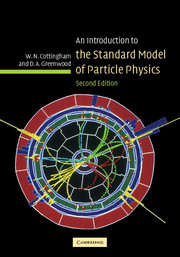Book contents
- Frontmatter
- Contents
- Preface to the second edition
- Preface to the first edition
- Notation
- 1 The particle physicist's view of Nature
- 2 Lorentz transformations
- 3 The Lagrangian formulation of mechanics
- 4 Classical electromagnetism
- 5 The Dirac equation and the Dirac field
- 6 Free space solutions of the Dirac equation
- 7 Electrodynamics
- 8 Quantising fields: QED
- 9 The weak interaction: low energy phenomenology
- 10 Symmetry breaking in model theories
- 11 Massive gauge fields
- 12 The Weinberg–Salam electroweak theory for leptons
- 13 Experimental tests of the Weinberg–Salam theory
- 14 The electromagnetic and weak interactions of quarks
- 15 The hadronic decays of the Z and W bosons
- 16 The theory of strong interactions: quantum chromodynamics
- 17 Quantum chromodynamics: calculations
- 18 The Kobayashi–Maskawa matrix
- 19 Neutrino masses and mixing
- 20 Neutrino masses and mixing: experimental results
- 21 Majorana neutrinos
- 22 Anomalies
- Epilogue
- Appendix A An aide-mémoire on matrices
- Appendix B The groups of the Standard Model
- Appendix C Annihilation and creation operators
- Appendix D The parton model
- Appendix E Mass matrices and mixing
- References
- Hints to selected problems
- Index
17 - Quantum chromodynamics: calculations
Published online by Cambridge University Press: 05 September 2012
- Frontmatter
- Contents
- Preface to the second edition
- Preface to the first edition
- Notation
- 1 The particle physicist's view of Nature
- 2 Lorentz transformations
- 3 The Lagrangian formulation of mechanics
- 4 Classical electromagnetism
- 5 The Dirac equation and the Dirac field
- 6 Free space solutions of the Dirac equation
- 7 Electrodynamics
- 8 Quantising fields: QED
- 9 The weak interaction: low energy phenomenology
- 10 Symmetry breaking in model theories
- 11 Massive gauge fields
- 12 The Weinberg–Salam electroweak theory for leptons
- 13 Experimental tests of the Weinberg–Salam theory
- 14 The electromagnetic and weak interactions of quarks
- 15 The hadronic decays of the Z and W bosons
- 16 The theory of strong interactions: quantum chromodynamics
- 17 Quantum chromodynamics: calculations
- 18 The Kobayashi–Maskawa matrix
- 19 Neutrino masses and mixing
- 20 Neutrino masses and mixing: experimental results
- 21 Majorana neutrinos
- 22 Anomalies
- Epilogue
- Appendix A An aide-mémoire on matrices
- Appendix B The groups of the Standard Model
- Appendix C Annihilation and creation operators
- Appendix D The parton model
- Appendix E Mass matrices and mixing
- References
- Hints to selected problems
- Index
Summary
Calculations in QCD have been made in two ways: lattice simulations at low energies, and perturbative calculations at high energies. In this chapter we outline some of the results obtained.
Lattice QCD and confinement
It was pointed out in Section 16.1 that, at low energies, a non-perturbative approach to QCD is needed. ‘Lattice QCD’ is such an approach. The gluon fields are defined on a four-dimensional lattice of points (nμ, n)a, where a is the lattice spacing and the nμ are integers. Field derivatives are replaced by discrete differences. This gives a ‘lattice regularised’ QCD. The lattice spacing corresponds to an ultraviolet cut-off, since wavelengths < 2a cannot be described on the lattice. A lattice does not have full rotational symmetry in space, but it is believed that nevertheless continuum QCD corresponds to the limit a → 0. Current computing power allows lattices of ∼(36)4 points. The range of the strong nuclear force is ∼ 1 fm. To fit such a distance comfortably on the lattice, we can anticipate that we shall not want a to be much less than (2fm)/36 = 0.056fm (and ℏc/a > 3.5 GeV).
In the high energy perturbation theory described in Section 16.3, the renormalisation parameter λ and the dimensionless coupling parameter g are combined to give a single physical parameter, Λ, having the dimensions of energy. The relationship between the effective coupling constant αs(Q2) and Λ in the lowest order of perturbation theory is given by (16.25).
- Type
- Chapter
- Information
- An Introduction to the Standard Model of Particle Physics , pp. 166 - 175Publisher: Cambridge University PressPrint publication year: 2007



